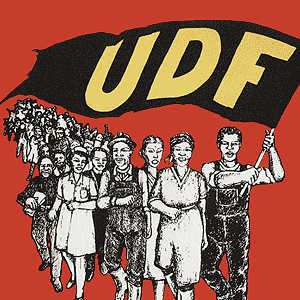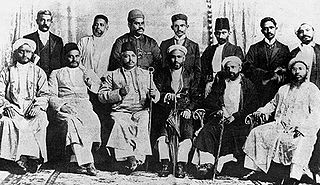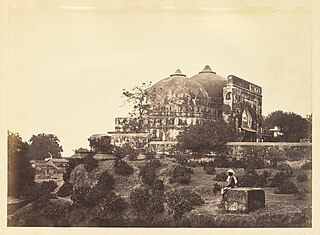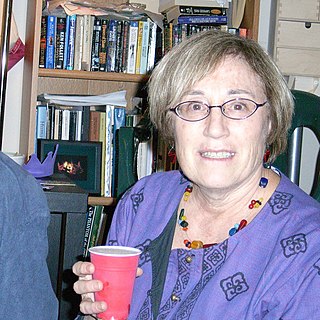Related Research Articles

Albert John Luthuli was a South African anti-apartheid activist, traditional leader, and politician who served as the President-General of the African National Congress from 1952 until his death in 1967.

Peter John Ucko FRAI FSA was an influential English archaeologist. He served as Director of the Institute of Archaeology at University College London (UCL), and was a Fellow of both the Royal Anthropological Institute and the Society of Antiquaries. A controversial and divisive figure within archaeology, his life's work focused on eroding western dominance by broadening archaeological participation to developing countries and indigenous communities.
The International Union for Prehistoric and Protohistoric Sciences (IUPPS) is a learned society, linked through the International Council for Philosophy and Humanistic Studies to UNESCO, and concerned with the study of prehistory and protohistory. In the words of its constitution:
Feminist archaeology employs a feminist perspective in interpreting past societies. It often focuses on gender, but also considers gender in tandem with other factors, such as sexuality, race, or class. Feminist archaeology has critiqued the uncritical application of modern, Western norms and values to past societies. It is additionally concerned with increasing the representation of women in the discipline of archaeology, and reducing androcentric bias within the field.
The Black Consciousness Movement (BCM) was a grassroots anti-apartheid activist movement that emerged in South Africa in the mid-1960s out of the political vacuum created by the jailing and banning of the African National Congress and Pan Africanist Congress leadership after the Sharpeville Massacre in 1960. The BCM represented a social movement for political consciousness.
[Black Consciousness'] origins were deeply rooted in Christianity. In 1966, the Anglican Church under the incumbent, Archbishop Robert Selby Taylor, convened a meeting which later on led to the foundation of the University Christian Movement (UCM). This was to become the vehicle for Black Consciousness.
Archaeological ethics refers to the moral issues raised through the study of the material past. It is a branch of the philosophy of archaeology. This article will touch on human remains, the preservation and laws protecting remains and cultural items, issues around the globe, as well as preservation and ethnoarchaeolog.

The United Democratic Front (UDF) was a South African popular front that existed from 1983 to 1991. The UDF comprised more than 400 public organizations including trade unions, students' unions, women's and parachurch organizations. The UDF's goal was to establish a "non-racial, united South Africa in which segregation is abolished and in which society is freed from institutional and systematic racism." Its slogan was "UDF Unites, Apartheid Divides." The Front was established in 1983 to oppose the introduction of the Tricameral Parliament by the white-dominated National Party government, and dissolved in 1991 during the early stages of the transition to democracy.

The Natal Indian Congress (NIC) was a political organisation established in 1894 to fight discrimination against Indians in the Natal Colony, and later the Natal Province, of South Africa. Founded by Mahatma Gandhi, it later served an important role in opposing apartheid. It was the oldest affiliate of the South African Indian Congress.

Swaraj Prakash Gupta was a prominent Indian archaeologist, art historian authority, Chairman of Indian Archaeological Society, founder of the Indian History and Culture Society, and Director of the Allahabad Museum. He was most noted for several excavations Indus Valley civilisation sites and for his support of the existence of a destroyed Ram Mandir underneath the Babri Masjid in Ayodhya.

The Comprehensive Anti-Apartheid Act of 1986 was a law enacted by the United States Congress. The law imposed sanctions against South Africa and stated five preconditions for lifting the sanctions that would essentially end the system of apartheid, which the latter was under at the time. Most of the sanctions were repealed in July 1991, after South Africa took steps towards meeting the preconditions of the act, with the final vestiges of the act being repealed in November 1993.
The academic boycott of South Africa comprised a series of boycotts of South African academic institutions and scholars initiated in the 1960s, at the request of the African National Congress, with the goal of using such international pressure to force the end to South Africa's system of apartheid. The boycotts were part of a larger international campaign of "isolation" that eventually included political, economic, cultural and sports boycotts. The academic boycotts ended in 1990, when its stated goal of ending apartheid was achieved.
The South African Liberal Students' Association (SALSA) exists to unify liberal student organisations across South African campuses. SALSA is the ideological descendant of the South African Liberal Association (SALA) (1936–1968), the first non-racial political organisation in South Africa, gathering many of its liberal principles and goals in its founding constitution. SALSA is a student organisation which is not aligned with any political party; and which believes in, practices and promotes the principles of liberal democracy on campuses.

The demolition of the Babri Masjid was carried out on 6 December 1992 by a large group of activists of the Vishva Hindu Parishad and allied organisations. The 16th-century Babri Masjid in the city of Ayodhya, in Uttar Pradesh, India, had been the subject of a lengthy socio-political dispute, and was targeted after a political rally organised by Hindu nationalist organisations turned violent.
Dora Ntloko Tamana OLG was a prominent South African anti-apartheid activist known for her unwavering commitment to social justice and equality. Her life and work were dedicated to challenging the oppressive apartheid regime in South Africa. Her experiences with the injustices perpetrated under apartheid fueled her determination to fight for society where all individuals would be treated equally regardless of race or background. Tamana's efforts contributed to the eventual dismantling of apartheid in South Africa.

Joan Margaret Gero was an American archaeologist and pioneer of feminist archaeology. Her research focused on gender and power issues in prehistory, particularly in the Andean regions of Argentina and Peru.
One World Archaeology is a book series focussing on archaeology and education about the past.
Angela McGowan is an Australian archaeologist known for her work on Aboriginal and European heritage and culture in Tasmania, Australia. McGowan predominantly worked in Heard Island, off the coast of Antarctica and Tasmania.

Peter G. Stone, is a British heritage professional and academic, who is the current UNESCO Chair in Cultural Property Protection and Peace at Newcastle University. He was the vice-president of Blue Shield International from 2017 to 2020, and was elected its president at the 2020 General Assembly. He is also a founding member and the chair of the UK Committee of that organisation.

Academic Freedom and Apartheid: The Story of the World Archaeological Congress by Peter Ucko is a personal account of the 1986 World Archaeological Congress (WAC), originally intended to be the eleventh congress of the International Union for Prehistoric and Protohistoric Sciences (IUPPS). Ucko, who organised the Congress, presents a linear account of how the Congress came to ban participation by South Africans and Namibians as part of the Academic boycott of South Africa, and how this led to it splitting from the IUPPS. It quotes extensively from sources such as correspondence, minutes, newspapers, WAC publicity, and others' accounts of the WAC.
The anti-apartheid movement was a worldwide effort to end South Africa's apartheid regime and its oppressive policies of racial segregation. The movement emerged after the National Party government in South Africa won the election of 1948 and enforced a system of racial segregation through legislation. Opposition to the apartheid system came from both within South Africa and the international community, in particular Great Britain and the United States. The anti-apartheid movement consisted of a series of demonstrations, economic divestment, and boycotts against South Africa. In the United States, anti-apartheid efforts were initiated primarily by nongovernmental human rights organizations. On the other hand, state and federal governments were reluctant to support the call for sanctions against South Africa due to a Cold War alliance with the country and profitable economic ties. The rift between public condemnation of apartheid and the U.S government's continued support of the South African government delayed efforts to negotiate a peaceful transfer to majority rule. Eventually, a congressional override of President Reagan's veto resulted in passage of the Comprehensive Anti-Apartheid Act in 1986. However, the extent to which the anti-apartheid movement contributed to the downfall of apartheid in 1994 remains under debate.
References
- ↑ Golson, Jack (1986). "The World Archaeological Congress, Southampton, and its aftermath". Australian Archaeology. 23: 100–105. doi:10.1080/03122417.1986.12093089 . Retrieved 11 May 2012.
- ↑ Gero, Joan. "Why? And Whither? WAC". National Park Service. Retrieved 11 May 2012.
- ↑ Golson, Jack (1986). "The World Archaeological Congress, Southampton, and its aftermath". Australian Archaeology. 23: 100–105. doi:10.1080/03122417.1986.12093089 . Retrieved 11 May 2012.
- ↑ Gero, Joan. "Why? And Whither? WAC". National Park Service. Retrieved 11 May 2012.
- ↑ Stone, Peter. 2006. ‘All Smoke and Mirrors...’ The World Archaeological Congress 1986-2004, in A Future for Archaeology, eds. Layton, R. Shennan, S. and Stone, P. UCL Press, London. 53-64.
- ↑ Bernbeck, Reinhard and Pollock, Susan. 1996. Ayodhya, Archaeology, and Identity. Current Anthropology, Vol. 37, No. 1, Supplement: Special Issue: Anthropology in Public. S138-S142.
- ↑ "WAC-6 COMMITTEES". WAC-6. Retrieved 24 June 2021.
- ↑ WAC-9 Prage 2022.